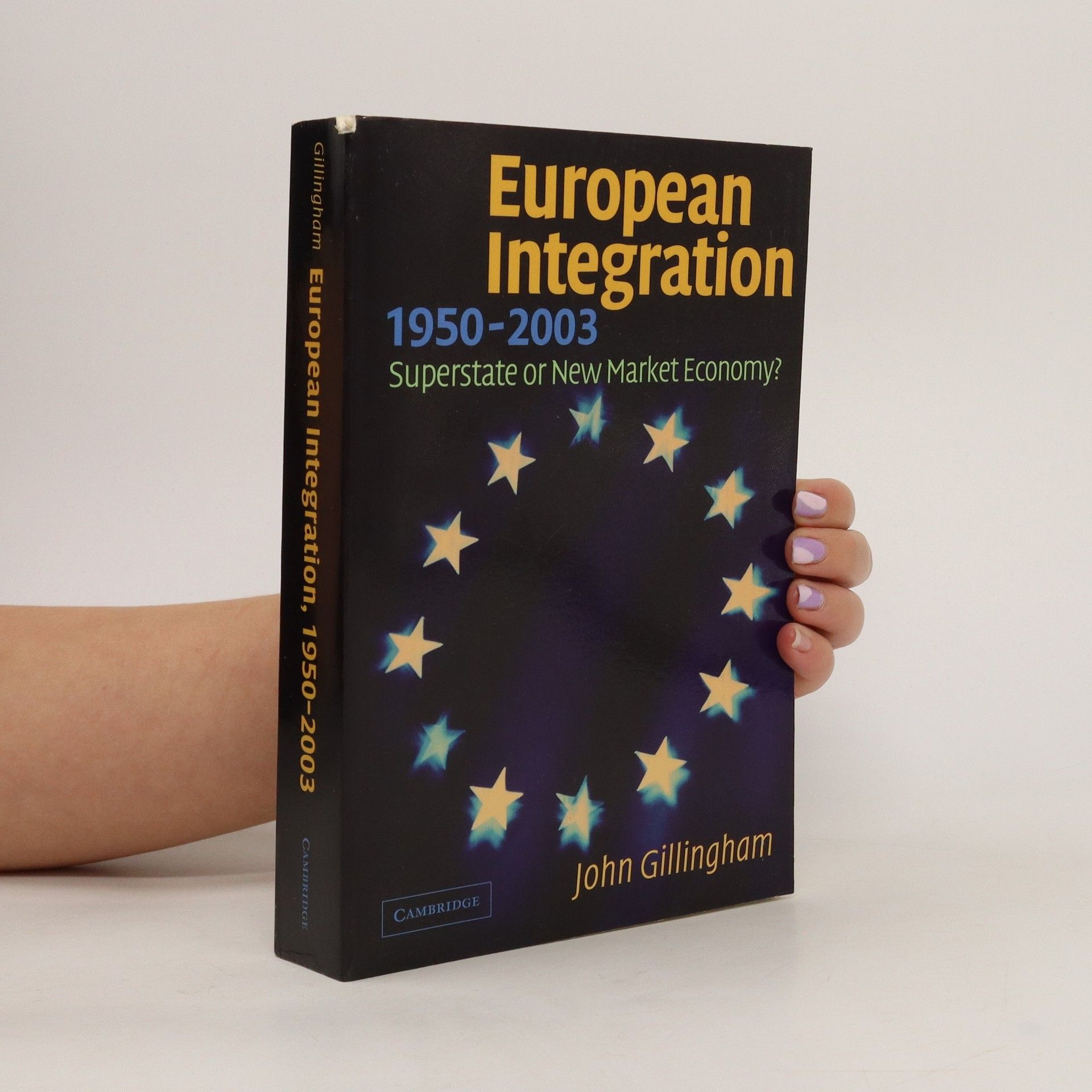William II (1087-1100), or William Rufus, will always be most famous for his death: killed by an arrow while out hunting, perhaps through accident or perhaps murder. But, as John Gillingham makes clear in this elegant book, as the son and successor to William the Conqueror it was William Rufus who had to establish permanent Norman rule. A ruthless, irascible man, he frequently argued acrimoniously with his older brother Robert over their father's inheritance - but he also handed out effective justice, leaving as his legacy one of the most extraordinary of all medieval buildings, Westminster Hall.
John Gillingham Ordine dei libri






- 2019
- 2018
The E.U. An Obituary
- 311pagine
- 11 ore di lettura
Is Brexit the beginning of the end for the EU? Fully updated and revised, this new edition of John R. Gillingham’s swingeing study explains why the European Union is so profoundly unsuited to the modern political economy. In a devastating historical account of political failure, he takes readers back to the union’s postwar origins, when it was considered the best means to guarantee peace, demonstrating how the flaws of the institution date to its origins. Today, these inherent failings leave it unable to deal with the most pressing issues of our time: the refugee crisis, Britain’s exit, the foundering eurozone, and the increasing disquiet among its member states. In a globalised marketplace where technological innovation transcends state boundaries, the EU is no longer fit for purpose. It is time to let the union dissolve.
- 2018
Anfang März 2018 sprach der der Autor John Gillingham sowohl in Annweiler am Trifels als auch in Göppingen, und eine große Zahl interessierter Zuhörer konnte einen bleibenden persönlichen Eindruck von einem der bedeutendsten englischen Mittelalter-Historiker der Gegenwart gewinnen. Der Hintergrund war die bevorstehende Eröffnung der Ausstellung „Richard Löwenherz. König - Ritter - Gefangener" im Historischen Museum der Pfalz in Speyer im September 2017. Die Geschichte der Gefangenschaft des englischen Königs bei Kaier Heinrich VI. und sein Aufenthalt auf der Burg Trifels haben dem Löwenherz-Mythos nicht nur einige besonders markante Züge verliehen, sondern waren für John Gillingham auch der Anlass, sich näher mit der deutschen Geschichte jener Zeit zu beschäftigen.
- 2017
Ryszard Lwie Serce
- 520pagine
- 19 ore di lettura
Przez średniowiecznych historyków porównywany do Karola Wielkiego i króla Artura, w późniejszej historiografii oceniany był wyłącznie przez pryzmat wypraw krzyżowych. Demonizowany przez wrogów, na czele z Filipem II, i sprowadzony do roli awanturnika przez protestanckich historyków, najbardziej... číst celé
- 2016
A major account of the failings of the European Union—and why it has to go The European Union is a besieged institution. It is struggling in vain to overcome the eurozone crisis and faces an influx of refugees not seen since World War II. The Schengen Agreement is a dead letter, and Britain stands on the brink of leaving altogether. The EU is unfit for the challenges of the coming age of increased global competition and high tech. In sum, the drive for an “ever-closer union” has set Europe on the wrong course: plunged it into depression, fuelled national antagonisms, debilitated democracy, and accelerated decline. In this pithy, rigorously argued book, leading historian John Gillingham examines a once great notion that soured long ago. From its postwar origins, through the Single Market, to the troubles of the present, Gillingham explains how Europe’s would-be government became a force for anti-democratic centralization and inept policy-making. Brussels has inspired a world of illusion that now threatens to undo the undoubted achievements of integration. The EU: An Obituary is an urgent call to the political Left, Right, and Centre to act before it is too late.
- 2016
Jak to bylo doopravdy: Nové objevy mění dějiny
- 319pagine
- 12 ore di lettura
Nové fascinující výsledky výzkumu mění zažitá historická fakta a náš pohled na minulost. Ne vše se stalo tak, jak bylo doposud vysvětlováno. V této poutavé knize se dozvíme např. pravdu o pravěkých předchůdcích člověka, jak to bylo se Stonehange, k čemu sloužila Magna charta libertatum, co doopravdy způsobilo zkázu vzducholodi Hindenburg, jaké vynálezy znali již staří Řekové, jak vypadala Kleopatra a mnoho dalších zajímavostí.
- 2015
William II
- 128pagine
- 5 ore di lettura
William II (1087-1100), or William Rufus, will always be most famous for his death: killed by an arrow while out hunting, perhaps through accident or perhaps murder. But, as John Gillingham makes clear in this elegant book, as the son and successor to William the Conqueror it was William Rufus who had to establish permanent Norman rule. A ruthless, irascible man, he frequently argued acrimoniously with his older brother Robert over their father's inheritance - but he also handed out effective justice, leaving as his legacy one of the most extraordinary of all medieval buildings, Westminster Hall.
- 2014
Conquests, Catastrophe and Recovery
- 368pagine
- 13 ore di lettura
Beginning with the Norman Conquest of England, these tumultuous centuries and their invasions shaped the languages and political geography of present-day Britain and Ireland. Magna Carta set new standards for holding governments to account and trial by jury won a central place in the legal systems of England and Scotland.
- 2013
Stereotactic Treatment of Epilepsy
Symposium under the Sponsorship of the European Society for Stereotactic and Functional Neurosurgery, Bratislava 1975
- 288pagine
- 11 ore di lettura
has further broadened controversial though this subject and indeed the results of amygdaloidotomy may be. lt was Jinnai in 1963 who first published his work on the control of intractable epilepsy by interruption of conduction pathways of the epileptic discharge using stereotactic lesions in the field of Forel. This was followed by lesions in the thalamus by Mullen in 1967, and by capsular lesions by Bertrand in 1970 and myself in 1971. In the macroscopic form this was carried out by section of the inter hemispheric cerebral connections by open operation by Vogel in 1969. This has been an important contribution to knowledge of the basic mechanisms of the propagation of the epileptic discharge and to our understanding of brain function but I would look to stereotactic techniques for the greater development potential. There are, of course, limitations. Bilateral lesions of effective size are difficult to achieve without side effects, particularly in respect of speech (notably dysarthria) and yet are essential if intractable epilepsy is to be con trolled in severity and frequency. Increased accuracy of target siting and control of the size of lesion are not the whole answer for inevi tably there are areas where important neuronal circuits are very crowded. But we should not underestimate the contribution of surgery. Increasingly the medical therapy of epilepsy is under scrutiny.
- 2008
The English in the Twelfth Century: Imperialism, National Identity and Political Values
- 320pagine
- 12 ore di lettura
Six of the greatest 12th-century historians are analysed in this collection of essays, focusing on questions of the newly-emerging English nationalism and the political importance of chivalric values and knightly obligations.


